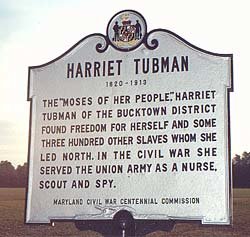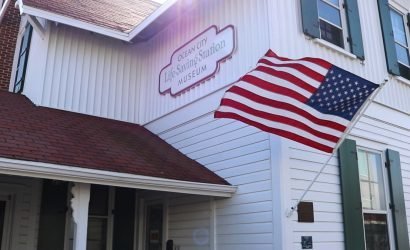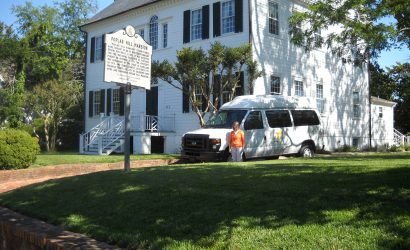Our $20 bills are going to look decidedly different in a few years, after U.S. Treasury Secretary Jack Lew announced this week that abolitionist and humanitarian Harriet Tubman would be taking the place of Andrew Jackson on the front of the $20 bill. Whether you are for or against the currency changes (we certainly won’t incite debate here at ShoreBread) we can all agree that it’s nice to see an Eastern Shore native gracing the new notes! In honor of Harriet Tubman, we decided to take a look at Tubman’s history on the Eastern Shore of Maryland and the local landmarks and museums that you can visit in Dorchester County to learn more about Tubman’s historical impact.
A Brief History
Harriet Tubman was born into slavery in Dorchester County sometime around the year 1820 as Araminta Ross, later changing her name to Harriet Tubman when she married a free black man named John Tubman. Tubman endured a difficult adolescence in slavery, experiencing multiple accounts of physical abuse, as well as watching three of her sisters get sold to distant plantations. According to historians, one time while at the market, Tubman refused to help an overseer punish another slave, leading the man to hit Tubman in the head with a two pound weight, causing permanent mental damage. As a likely result, Tubman continually suffered seizures, headaches and narcoleptic episodes for the rest of her life.
When Tubman’s master died, she successfully escaped with her two brothers to Philadelphia. As a reward for their capture, a local newspaper advertised a $300 compensation. Her brothers started to doubt their safety while in Pennsylvania and decided to return to Maryland while Tubman remained up north. In 1850 however, Tubman learned that her niece Kessiah and her two children were being sold at auction and would most likely be moved somewhere far away. Luckily, Kessiah’s husband won the bid for his wife and children but the family still feared for their safety. To insure their protection, Tubman helped to move the entire family to freedom in Philadelphia.
Soon, Tubman was moving her parents, siblings and other slaves through the Underground Railroad to freedom above the Mason-Dixon Line. She became very efficient at helping people escape slavery, guiding over 90 people north and earning the nickname Moses along the way. In 1850 the Fugitive Slave Act was passed which made it legal for slave owners to reclaim escaped slaves if they were found up north. This piece of legislation did not discourage Tubman but instead spurred her to extend the Underground Railroad to Canada, where slavery was illegal. Tubman was once quoted saying “I was the conductor of the Underground Railroad for eight years, and I can say what most conductors can’t say; I never ran my train off the track and I never lost a passenger.”
Tubman also had a significant impact on the Civil War, working as a cook and nurse and later as a scout and a spy. She was also the first woman to lead an armed expedition in the war when she guided the Combahee River Raid, which liberated over 700 slaves. Tubman died in 1914 of pneumonia and was buried with military honors.
Local Landmarks: Finding a Way to Freedom Driving Tour
This 125-mile driving tour includes 28 stops across Dorchester and Caroline Counties, taking you through the places, sites and scenes of Tubman’s life and along the historical track of the region’s 19th century Underground Railroad. Stops include churches and meeting houses, home sites, and the area’s natural habitat such as forests and rivers that Tubman utilized during her daring rescue missions. The tour also includes stops at area museums and court houses that memorialize the pursuit of freedom through the Underground Railroad.
The tour begins at the Dorchester County Visitor Center, where you can find an exhibition on Harriet Tubman and Dorchester County’s role in the Underground Railroad. Another notable stop is at the Dorchester County Court House, where Tubman’s niece, Kessiah, and her two children escaped from the auction block, eventually finding their way to Baltimore where they met Tubman and continued north to Philadelphia. The Harriet Tubman Museum and Educational Center is a non-profit educational and informational center offering specialized tours and information on Tubman. Another notable site is the Bucktown Village Store, aptly titled as “the site of Harriet Tubman’s first act of defiance.” It was here that Tubman was almost killed by a blow to the head while attempting to help a fellow enslaved man. Poplar Neck serves as the site of one of Tubman’s most daring rescues. It was from here that she led her three brothers’ to freedom on Christmas Day 1854, later returning to rescue her parents in 1857.
Interested in the full tour? The 125-mile driving tour across Dorchester and Caroline Counties takes roughly six-hours to complete. Visit the Dorchester County Visitor Center for more information.
Bills, Bills, Bills
Tubman will be the first woman honored on paper currency in the U.S., with the exception of Martha Washington’s brief stint on the $1 silver certificate in the late 19-century. Tubman will take the place of Andrew Jackson on the front of the $20 bills; Jackson will move to the back of the bill. Originally, plans called for Alexander Hamilton, who is currently on the front of the $10 bill, to be replaced, but after a strong outcry from Hamilton supporters (due in large part to the Broadway success of Hamilton), Hamilton will remain on the $10 bill. The backs of the $5 and $10 bills will see some also see some changes. The picture of the Treasury building on the back of the $10 bill will be replaced with a depiction of a 1913 march in support of women’s right to vote, along with the portraits of five suffrage leaders: Lucretia Mott, Sojourner Truth, Elizabeth Cady Stanton, Alice Paul, and Susan B. Anthony. On the back of the $5 bill, will be images of Marian Anderson’s 1939 performance at the Lincoln Memorial (after being barred from Constitution Hall), along with images of Eleanor Roosevelt and Dr. Martin Luther King Jr.s “I have a dream” speech. The design for the new notes will be revealed in 2020; the release date of the new bills is yet to be announced.









